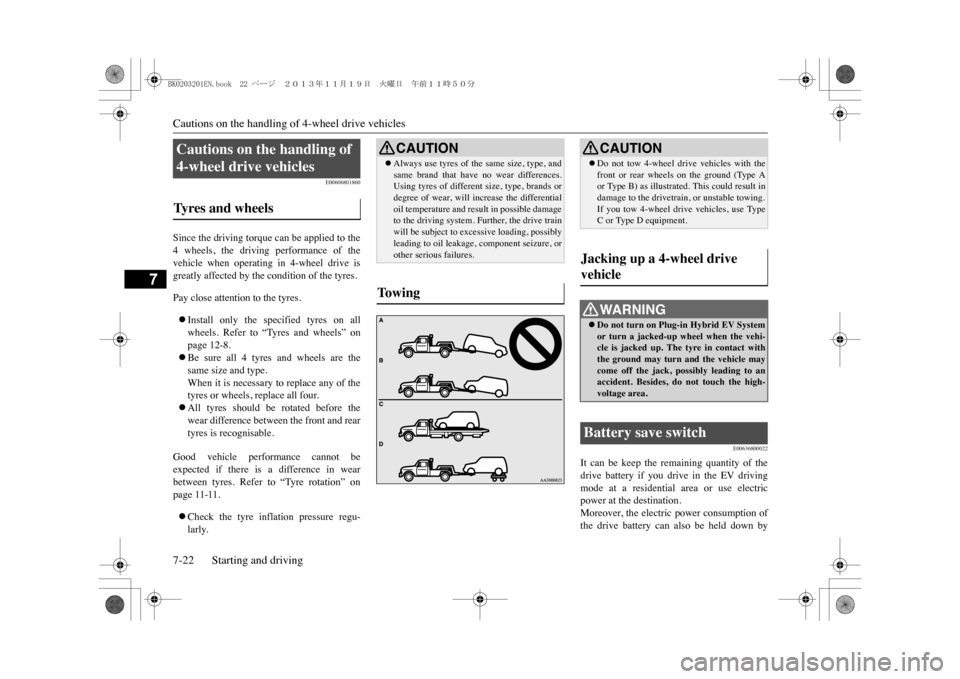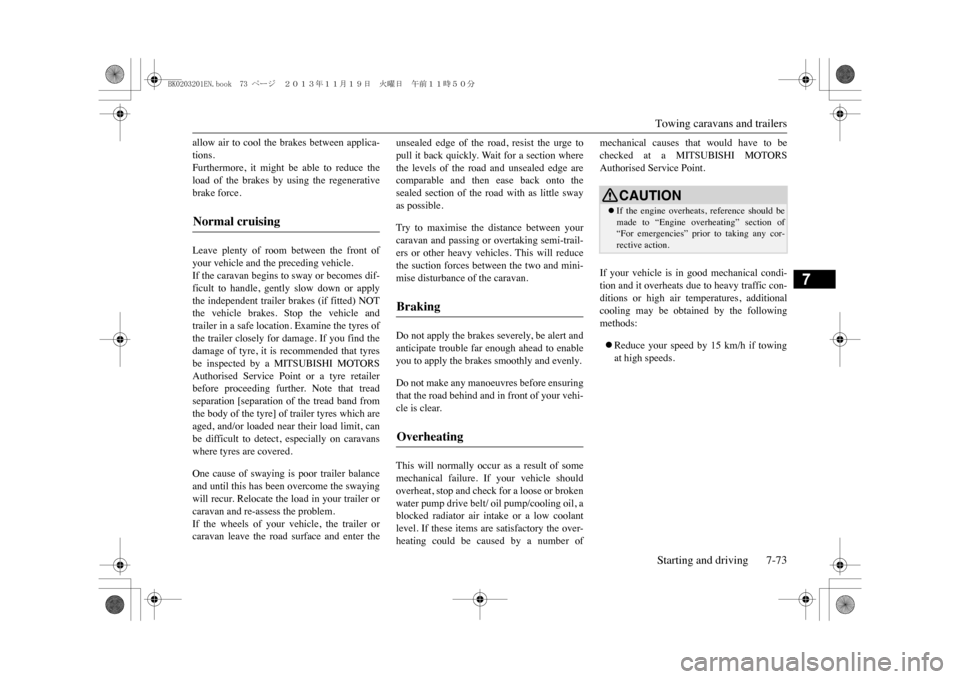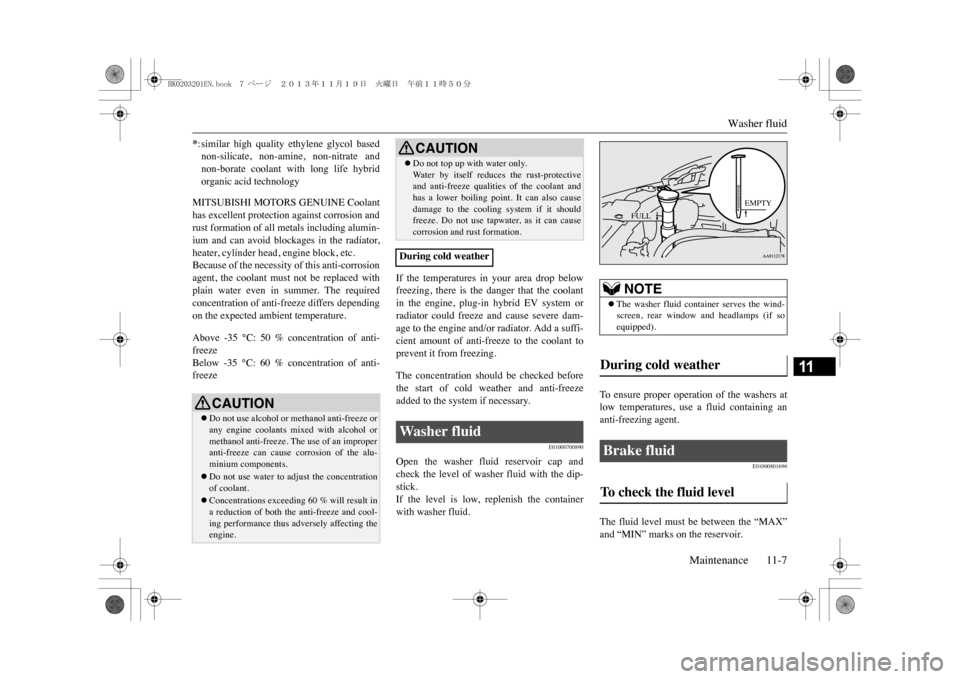2014 MITSUBISHI OUTLANDER SPORT oil temperature
[x] Cancel search: oil temperaturePage 185 of 388

Cautions on the handling of 4-wheel drive vehicles7-22 Starting and driving
7
E00606801860
Since the driving torque can be applied to the4 wheels, the driving performance of thevehicle when operating in 4-wheel drive isgreatly affected by the condition of the tyres.Pay close attention to the tyres.�zInstall only the specified tyres on allwheels. Refer to “Tyres and wheels” onpage 12-8.�zBe sure all 4 tyres and wheels are thesame size and type.When it is necessary to replace any of thetyres or wheels, replace all four.�zAll tyres should be rotated before thewear difference between the front and reartyres is recognisable.
Good vehicle performance cannot beexpected if there is a difference in wearbetween tyres. Refer to “Tyre rotation” onpage 11-11.�zCheck the tyre inflation pressure regu-larly.
E00636800022
It can be keep the remaining quantity of thedrive battery if you drive in the EV drivingmode at a residential area or use electricpower at the destination.Moreover, the electric power consumption ofthe drive battery can also be held down by
Cautions on the handling of 4-wheel drive vehicles Ty r e s a n d w h e e l s
CAUTION�zAlways use tyres of the same size, type, andsame brand that have no wear differences.Using tyres of different size, type, brands ordegree of wear, will increase the differentialoil temperature and result in possible damageto the driving system. Further, the drive trainwill be subject to exce
ssive loading, possibly
leading to oil leakage, component seizure, orother serious failures.
To w i n g
CAUTION�zDo not tow 4-wheel driv
e vehicles with the
front or rear wheels on the ground (Type Aor Type B) as illustrated. This could result indamage to the drivetrain, or unstable towing.If you tow 4-wheel drive vehicles, use TypeC or Type D equipment.
Jacking up a 4-wheel drive vehicle
WA R N I N G�zDo not turn on Plug-in Hybrid EV Systemor turn a jacked-up wheel when the vehi-cle is jacked up. The tyre in contact withthe ground may turn and the vehicle maycome off the jack, possibly leading to anaccident. Besides, do not touch the high-voltage area.
Battery save switch
BK0203201EN.book 22 ページ 2013年11月19日 火曜日 午前11時50分
Page 236 of 388

Towing caravans and trailersStarting and driving 7-73
7
allow air to cool the brakes between applica-tions.Furthermore, it might be able to reduce theload of the brakes by using the regenerativebrake force.Leave plenty of room between the front ofyour vehicle and the preceding vehicle.If the caravan begins to sway or becomes dif-ficult to handle, gently slow down or applythe independent trailer brakes (if fitted) NOTthe vehicle brakes. Stop the vehicle andtrailer in a safe location. Examine the tyres ofthe trailer closely for damage. If you find thedamage of tyre, it is recommended that tyresbe inspected by a MITSUBISHI MOTORSAuthorised Service Point or a tyre retailerbefore proceeding further. Note that treadseparation [separation of the tread band fromthe body of the tyre] of trailer tyres which areaged, and/or loaded near their load limit, canbe difficult to detect, especially on caravanswhere tyres are covered.One cause of swaying is poor trailer balanceand until this has been overcome the swayingwill recur. Relocate the load in your trailer orcaravan and re-assess the problem.If the wheels of your vehicle, the trailer orcaravan leave the road surface and enter the
unsealed edge of the road, resist the urge topull it back quickly. Wait for a section wherethe levels of the road and unsealed edge arecomparable and then ease back onto thesealed section of the road with as little swayas possible.Try to maximise the distance between yourcaravan and passing or overtaking semi-trail-ers or other heavy vehicles. This will reducethe suction forces between the two and mini-mise disturbance of the caravan.Do not apply the brakes severely, be alert andanticipate trouble far enough ahead to enableyou to apply the brakes smoothly and evenly.Do not make any manoeuvres before ensuringthat the road behind and in front of your vehi-cle is clear.This will normally occur as a result of somemechanical failure. If your vehicle shouldoverheat, stop and check for a loose or brokenwater pump drive belt/ oil pump/cooling oil, ablocked radiator air intake or a low coolantlevel. If these items are satisfactory the over-heating could be caused by a number of
mechanical causes that would have to bechecked at a MITSUBISHI MOTORSAuthorised Service Point.If your vehicle is in good mechanical condi-tion and it overheats due to heavy traffic con-ditions or high air temperatures, additionalcooling may be obtained by the followingmethods:�zReduce your speed by 15 km/h if towingat high speeds.
Normal cruising
Braking Overheating
CAUTION�zIf the engine overheats,
reference should be
made to “Engine overheating” section of“For emergencies” prior to taking any cor-rective action.
BK0203201EN.book 73 ページ 2013年11月19日 火曜日 午前11時50分
Page 338 of 388

Cleaning the exterior of your vehicle
Vehicle care 10-3
10
E00900500207
1. To maintain the value of your new vehi-cle, handle the upholstery carefully andkeep the interior clean.Use a vacuum cleaner and brush to cleanthe seats. If stained, vinyl and syntheticleather should be cleaned with an appro-priate cleaner. Cloth fabrics can becleaned with either upholstery cleaner or amild soap and water solution.2. Clean the carpeting with a vacuumcleaner and remove any stains with carpetcleaner. Oil and grease can be removed bylightly dabbing with a clean colourfastcloth and stain remover.
E00900600950
1. To clean, lightly wipe the leather with asoft cloth soaked in a mild soap and watersolution.2. Dip cloth in fresh water and wring it outwell. Using this cloth, wipe off the deter-gent thoroughly.3. Apply leather protecting agent to the gen-uine leather surface.
E00900700108
If the following is left on your vehicle, it maycause corrosion, discolouration and stains,wash the vehicle as soon as possible.�zSeawater, road deicing products.
�zSoot and dust, iron powder from factories,chemical substance (acids, alkalis, coal-tar, etc.).�zDroppings from birds, carcasses ofinsects, tree sap, etc.
E00900903547
Chemicals contained in the dirt and dustpicked up from the road surface can damagethe paint coat and body of your vehicle if leftin prolonged contact.Frequent washing and waxing is the best wayto protect your vehicle from this damage.This will also be effective in protecting itfrom environmental elements such as rain,snow, salt air, etc.Do not wash the vehicle in direct sunlight.Park the vehicle in the shade and spray it withwater to remove dust. Next, using an ampleamount of clean water and a car washingbrush or sponge, wash the vehicle from top tobottom.Use a mild car washing soap if necessary.Rinse thoroughly and wipe dry with a softcloth. After washing the vehicle, carefullyclean the joints and flanges of the doors, bon-net and other sections where dirt is likely toremain.
Upholstery Genuine leather
*
NOTE
�zIf genuine leather is
wet with water or is
washed in water, wipe off water as quickly aspossible with a dry, soft cloth.If left damp, mildew may grow.�zOrganic solvents such as benzine, kerosene,alcohol and petrol, acid or alkaline solventsmay discolour the genui
ne leather surface.
Be sure to use neutral detergents.�zRemove dirty patche
s or oil substances
quickly as they can stain genuine leather.�zThe genuine leather surface may harden andshrink if it is exposed to direct rays of thesun for long hours. When your vehicle isparked, place it in the shade as much as pos-sible.�zWhen the temperature of the vehicle interiorrises in summer, vinyl products left on thegenuine leather seat may deteriorate andstick to the seat.
Cleaning the exterior of your vehicle
Was hi n g
BK0203201EN.book 3 ページ 2013年11月19日 火曜日 午前11時50分
Page 346 of 388

Engine oil
Maintenance 11-5
11
E01000404039
The engine oil used has a significant effect onthe engine’s performance, service life andstartability. Be sure to use oil of the recom-mended quality and appropriate viscosity.All engines consume a certain amount of oilduring normal operation. Therefore, it isimportant to check the oil level at regularintervals or before starting a long trip.1. Park the car on a horizontal surface.2. Switch off the engine.3. Wait a few minutes.4. Remove the dipstick and wipe it with aclean cloth.5. Reinsert the dipstick as far as it goes.
6. Remove the dipstick and read the oillevel, which should always be within therange indicated7. If the oil level is below the specified limit,remove the cap located on the cylinderhead cover and add enough oil to raise thelevel to within the specified range. Do notoverfill to avoid engine damage. Be sureto use the specified engine oil and do notmix various types of oil.8. After adding oil, close the cap securely.9. Confirm the oil level by repeating step 4to 6.
�zSelect engine oil of the proper SAE vis-cosity number according to the atmos-pheric temperature.SAE 0W-20, 0W-30, 5W-30, and 5W-40engine oils can only be used if they meetACEA A3/B3, A3/B4 or A5/B5 and APISG (or higher) specifications.�zUse engine oil conforming to the follow-ing classification:•API classification: “For service SG” orhigher•ILSAC certificated oil•ACEA classification:“For service A1/B1, A3/B3, A3/B4, orA5/B5”
Engine oil To c h e c k a n d r e f i l l e n g i n e o i l
FULL LOW
NOTE
�zThe engine oil will dete
riorate rapidly if the
vehicle is subjected to severe conditions,requiring earlier oil replacement.Please refer to the maintenance schedule.�zFor information on how to dispose of usedengine oil, refer to page 2-15.
Recommended engine oil vis-cosity
BK0203201EN.book 5 ページ 2013年11月19日 火曜日 午前11時50分
Page 348 of 388

Washer fluid
Maintenance 11-7
11
MITSUBISHI MOTORS GENUINE Coolanthas excellent protection against corrosion andrust formation of all metals including alumin-ium and can avoid blockages in the radiator,heater, cylinder head, engine block, etc.Because of the necessity of this anti-corrosionagent, the coolant must not be replaced withplain water even in summer. The requiredconcentration of anti-freeze differs dependingon the expected ambient temperature.Above -35 °C: 50 % concentration of anti-freezeBelow -35 °C: 60 % concentration of anti-freeze
If the temperatures in your area drop belowfreezing, there is the danger that the coolantin the engine, plug-in hybrid EV system orradiator could freeze and cause severe dam-age to the engine and/or radiator. Add a suffi-cient amount of anti-freeze to the coolant toprevent it from freezing.The concentration should be checked beforethe start of cold weather and anti-freezeadded to the system if necessary.
E01000700890
Open the washer fluid reservoir cap andcheck the level of washer fluid with the dip-stick.If the level is low, replenish the containerwith washer fluid.
To e n s u r e p r o p e r o p e r a t i o n o f t h e w a s h e r s a tlow temperatures, use a fluid containing ananti-freezing agent.
E01000801696
The fluid level must be between the “MAX”and “MIN” marks on the reservoir.
*: similar high quality ethylene glycol basednon-silicate, non-amine, non-nitrate andnon-borate coolant with long life hybridorganic acid technologyCAUTION�zDo not use alcohol or methanol anti-freeze orany engine coolants
mixed with alcohol or
methanol anti-freeze. The use of an improperanti-freeze can cause corrosion of the alu-minium components.�zDo not use water to adjust the concentrationof coolant.�zConcentrations exceeding 60 % will result ina reduction of both the anti-freeze and cool-ing performance thus adversely affecting theengine.
�zDo not top up with water only.Wa t e r b y i t s e l f r e d u c e s t h e r u s t - p r o t e c t i v eand anti-freeze qualities of the coolant andhas a lower boiling point. It can also causedamage to the cooling system if it shouldfreeze. Do not use tapwater, as it can causecorrosion and rust formation.
During cold weatherWa s h e r f l u i d
CAUTION
NOTE
�zThe washer fluid container serves the wind-screen, rear window and headlamps (if soequipped).
During cold weather Brake fluid To c h e c k t h e f l u i d l e v e l
EMPTY
FULL
BK0203201EN.book 7 ページ 2013年11月19日 火曜日 午前11時50分
Page 351 of 388

Tyres11-10 Maintenance
11
E01001402726
*: Above 160 km/hCheck the tyre inflation pressure of all the tyres while they ar
e cold; if insufficient or excessive, adjust to the specified v
alue.
After the tyre inflation pressure has been adjusted, check the tyres for damage and air leaks. Be sure to put caps on the valve
s.
E01001801970
Check the tyres for cuts, cracks and otherdamage. Replace the tyres if there are deep
cuts or cracks. Also check each tyre forpieces of metal or pebbles.The use of worn tyres can be very dangerousbecause of the greater chance of skidding orhydroplaning. The tread depth of the tyresmust exceed 1.6 mm in order for the tyres tomeet the minimum requirement for use.Tread wear indicators will appear on the sur-face of the tyre as the tyre wears, therebyindicating that the tyre no longer meets theminimum requirement for use. When thesewear indicators appear, the tyres must bereplaced with new ones.When replacement of any of the tyres is nec-essary, replace all of them.
Ty r e i n f l a t i o n p r e s s u r e s
Ty re s i z e
Front
Rear
215/70R16 100H
2.4 bar (35 PSI) [240 kPa], 2.6 bar (38 PSI) [260 kPa]
*
225/55R18 98H
2.4 bar (35 PSI) [240 kPa]], 2.6 bar (38 PSI) [260 kPa]
*
Wheel condition 1- Location of the tread wear indicator2- Tread wear indicator
CAUTION�zAlways use tyres of the same size, sametype, and same brand, and which have nowear differences. Using tyres of differentsize, type, brands or
degree of wear, will
increase the differential oil temperature,resulting in possible damage to the drivingsystem. Further, the drive train will be sub-jected to excessive loading, possibly leadingto oil leakage, component seizure, or otherserious faults.
BK0203201EN.book 10 ページ 2013年11月19日 火曜日 午前11時50分